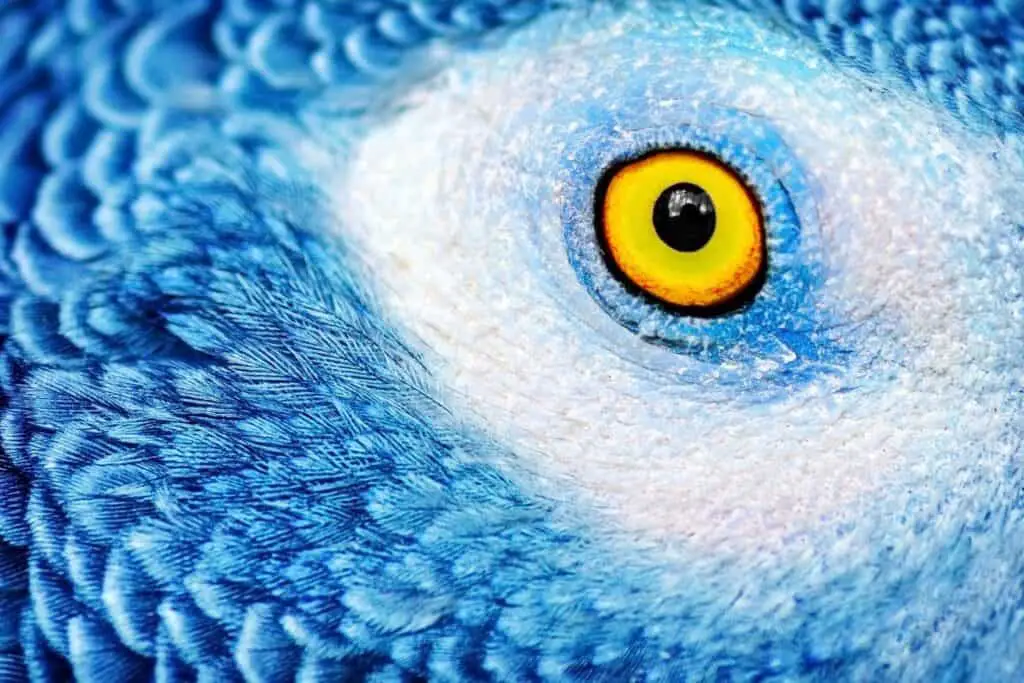Scientific studies have revealed an astounding amount of visual adaptations in parrots’ eyes, which are remarkable given the lack of a clear understanding of how they see. Birds are tetrachromats, which means they can perceive four colors: ultraviolet, blue, green, and red. On the other hand, humans only see three colors.
Check out some fun facts about parrots’ eyes here:
- parrots have better vision than humans
- parrots can see various colors
- parrots can hardly see in the dark
- parrots have monocular vision
- parrots have excellent peripheral vision
Let’s take a deeper look (no pun intended) into each of these amazing facts to learn more about our feathered friends. Are you ready? Let’s dive in!
Parrots Have Better Vision Than Humans
Birds are bizarre. Although some birds have varying abilities and senses, most have better vision than humans, that includes parrot eyes.
Birds are tetrachromats, which means they can sense ultraviolet light. Notice that the “color” shown above is fake since, by definition, UV light has no color. It’s made visible by humans through our eyes.
Parrots Can See Various Colors
Although there are no conclusive studies as to how many colors can parrot seen, Joe Smith, an ornithologist, states that birds can detect a wide range of colors. Parrots have a vision that is reportedly anywhere from two to eight times sharper than mammals.
It is why parrots, unlike humans, can see a larger spectrum of colors and distinguish between various shades. Birds, like humans, have five different types of cones; four single cones contribute to tetrachromatic color vision (people only have three: blue, green, and red), and one double cone is thought to aid with achromatic motion perception.
Most Parrots Can Hardly See In The Dark
Although parrots have excellent vision during the day, they may have impaired vision at night. There are possible reasons. It could be because there are fewer rods and cones in their retinas, which makes it hard for them to see at night.
Even though rods can provide dim light, cone photoreceptors require a lot of illumination to see appropriately. Compared to humans, side-eyed birds have better peripheral vision and depth perception. They also lack photoreceptors, which means that they have poor night vision.
Although a parrot can’t see well at night, you can provide illumination at all times. You must turn off the lights to ensure the animal can sleep well at night.
Make sure your parrot has a familiar place to sleep, as it will most likely stay up late if you don’t. It will allow them to rest while doing what they naturally can.
Parrots Have Monocular Vision

The eyes of a parrot provide them with extended peripheral vision, which helps them fly. It’s because they need 360-degree vision, or flying through the jungle could be a problem. This type of vision, referred to as monovision, is unlike that of animals with monocular vision (even though the words sound quite similar).
Parrots, like many other birds, often have monocular vision, in which each eye sees something somewhat different. Various species of birds rely on distinct types of vision to make it in the wild. Birds like parrots benefit significantly from having their eyes on the sides of their heads.
Many species of birds cannot see very well in the dark, which may cause them to feel very vulnerable.
The sudden change from light to darkness can startle them, which may, in turn, cause them to become disoriented, which could lead to a great deal of trouble caused by them.
They have an innate fear of being attacked by predators. Thus being in the dark makes them feel uneasy. Birds not acclimated to the surroundings in which they live may experience heightened anxiety throughout the nighttime hours. Both are transferring their cage to a new area and moving into a new house are potential triggers that could bring on this disease in your pet.
Parrots Have Great Peripheral Vision
A parrot can process information about what it sees faster than a person can. Thus, parrots eyes let it notice small changes in their environment and avoid situations that could be dangerous.
However, just because parrots have such incredible vision does not mean that the birds eyes are somehow going to be safe from problems. Just like humans, birds can have serious eye problems.
Because vision is so important to our feathery friends, you can often discern issues with eye health versus behavioral.
For example, a parrot
will display interesting behaviors when in a good mood and curious about something. The move is called pinning, and they do it when they are sort of playful, but also curious.
I used to have a pet Amazon who would ‘pin’ his eyes every time I came over to say hello.
So, here’s how pinning works. A parrot will make it’s pupils go really small on purpose, when they are normally quite big. Think of it as consciously de-focusing your eyes. Parrots do it when curious and happy.
Some male parrots include pinning as a part of their mating dance.
However, parrots might also use pinning and fluffing up of their feathers to denote they are feeling threatened. The trick to knowing the difference is in how rigid their body language becomes. If really rigid, they might be really scared or upset. Watch out because that means they are ready to bite. Just like a snake getting ready to strike. So, watch that body language, it tells all tales.
A parrot that has eye problems might have an issue with pinning that is neither aggressive or fearful behavior or happy curiosity. If you see them pinning without rigidity, without feather puffing up, and seemingly for no reason, it might be a warning sign of eye problems and you should consider a trip to the vet with your bird.
Common Causes Of Parrots Eye Problems
Your bird might have a few fairly common parrots eye problems. For example, birds’ eyes can get infections from bacteria, viruses, and fungi. Parasites can even get into the eyes of birds. The following are some of the most common eye problems in parrots:
- Deficiency in Vitamin A
- Trauma or ulceration
- Dirty environment
- Environmental toxins (chemicals, ammonia, or airborne toxins)
- Fungi (Candida albicans, or Aspergillus spp.)
- Periorbital or orbital disease
- Viruses, such as adenovirus, pneumovirus, paramyxovirus, herpesvirus, poxvirus, Newcastle virus, Bacteria (Escherichia coli, Chlamydia psittaci, Clostridium botulinum, Staphylococcus spp., Corynebacterium spp., or Mycoplasma spp.)
- Parasites, like spirurids, nematodes, or trematodes
- Foreign bodies, like millet seeds, seed husks, or feathers
How To Manage Your Pet Parrots Eye Problems
Unfortunately, many birds experience vision problems. Although unpleasant, they often pose no serious health risk. Thus, it suggests the bird is not going to die soon. When things are normal, gaze through your bird’s eye. Infections and other potentially fatal illnesses need prompt medical attention because they can progress quickly.
Different eye-saving medicines and topical antibiotics are available from your vet. By taking these measures, you can avoid further vision loss in parrots’ eyes. You should see a vet immediately if your parrot’s eyes are not improving after receiving treatment. They will give you whatever medicine you need to help them get better.
Preventing Eye Infections
When purchasing a parrot free of conjunctivitis (eye infection), it is crucial to choose a reputable breeder. They will most likely follow good avian husbandry practices.
Also, immediately taking your feathery friend to the vet is best if you suspect they have conjunctivitis, a contagious eye infection. It has the potential to avert fatal health complications.
The Centers for Disease Control and Prevention (CDC) suggests you quarantine a new bird for up to 30 days. This preventive measure will allow you to keep the bird healthy and disease-free.
You should provide a low-stress environment to improve its health and prevent illness. You can do this through preventative husbandry, such as ensuring that the bird’s cage is regularly rearranged.
Removing Foreign Objects
If you notice a foreign object in your bird’s eye, it should be removed without damage. It can be a seed hull, rope, or eyelash. Removing it as soon as possible is essential to avoid hurting it.
Due to cleaning with aerosol chemicals, birds are at risk from dust that can get into the parrots’ eyes. It is why it’s essential to flush their eyes. You should thoroughly rinse their eyes using either a saline solution or an eye wash that has not been tampered with.
You can use a syringe to flush the eyes if you don’t have any. After thoroughly rinsing the look, use a cotton ball to clean the region.
Conclusion
Unlike humans, parrots have eyes on the sides of their heads. They can see things in front of them. Although they can see in the dark, they have poor night vision due to the lack of rods and cones in their retinas.
The statement doesn’t imply that they are completely blind at night. Even though they have a reduced field of vision, they have better peripheral vision.
In addition, they have a superior sense of color compared to humans. You can keep your parrots in a secure environment and inside a cage to avoid accidents at night. It would be best if you also covered them when they sleep.
- Utaraite, Neringa. “This Is How Birds See the World As Compared To Humans, And It’s Pretty Amazing.” Bored Panda. Accessed December 12, 2022. https://www.boredpanda.com/human-vs-bird-vision/?utm_source=google&utm_medium=organic&utm_campaign=organic
- Jackson, Hazel. “How Do Birds See Where They’re Going? Biology Explains.” Inverse. September 30, 2018. https://www.inverse.com/article/49382-how-birds-can-see-with-eyes-on-the-side-of-their-heads#
- “Parrot Eyes Anatomy: All You Need To Know.” Parrot Junkie. Accessed December 12, 2022. https://www.parrotjunkie.com/health/parrot-eyes-anatomy/
- “7 Eye Parrot Problems And What To Do About Them.” Bird Supplies. Accessed December 12, 2022. https://birdsupplies.com/pages/parrot-eye-problems
- Holden, Natasha. “Conjunctivitis: How to Detect Eye Infections in Your Pet Bird.” Midog Test. September 30, 2021. https://www.midogtest.com/post/conjunctivitis-eye-infections-bird




